 W
WSalmon is the common name for several species of ray-finned fish in the family Salmonidae. Other fish in the same family include trout, char, grayling, and whitefish. Salmon are native to tributaries of the North Atlantic and Pacific Ocean. Many species of salmon have been introduced into non-native environments such as the Great Lakes of North America and Patagonia in South America. Salmon are intensively farmed in many parts of the world.
 W
WAquAdvantage salmon is a genetically engineered (GE) Atlantic salmon developed by AquaBounty Technologies in 1989. The typical growth hormone-regulating gene in the Atlantic salmon was replaced with the growth hormone-regulating gene from Pacific Chinook salmon, with a promoter sequence from ocean pout. This gene enables the GM salmon to grow year-round instead of only during spring and summer.
 W
WThe Atlantic salmon is a species of ray-finned fish in the family Salmonidae which is the largest salmon and can grow up to a meter in length. It is found in the northern Atlantic Ocean and in rivers that flow into this ocean. Most populations of this fish species are anadromous, hatching in streams and rivers but moving out to sea as they grow where they mature, after which the adult fish seasonally move upstream again to spawn.
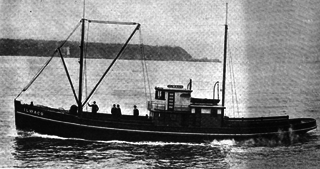 W
WA cannery tender was a type of commercial fishing vessel operated by salmon canneries in the early to mid- 20th century. Most commonly used in the Pacific Northwest and Alaska, cannery tenders transported fish from cannery-owned fish traps to canneries. Cannery tenders also transported men and supplies to set up and maintain the fish traps and patrolled the area around fish traps to protect them from fish pirates.
 W
WSalmon population levels are of concern in the Atlantic and in some parts of the Pacific. Salmon are anadromous - they rear and grow in freshwater, migrate to the ocean to reach sexual maturity, and then return to freshwater to spawn. Determining how environmental stressors and climate change will affect these fisheries is challenging due to their lives split between fresh and saltwater. Environmental variables like warming temperatures and habitat loss are detrimental to salmon abundance and survival. Other human influenced effects on salmon like overfishing and gillnets, sea lice from farm raised salmon, and competition from hatchery released salmon have negative effects as well.
 W
WArthur Davis Hasler was an ecologist who is credited with explaining the salmon's homing instinct. Hasler was a member of the National Academy of Sciences and the American Academy of Arts and Sciences. The New York Times called him "an internationally recognized authority on freshwater ecology". He served as President of The Ecological Society of America, which called him "one of the leading figures in 20th century freshwater ecology". Hasler pioneered a research method based on manipulation of entire lake ecosystems. This method became an instrumental new tool for ecology. He published over 200 scientific papers, was an author or an editor of 7 books, and supervisor of 52 doctoral degrees.
 W
WIn the parlance of the Pacific Northwest of the United States, June hogs were the largest Chinook salmon caught in the summer migratory runs of the fish. Often weighing at 80 pounds (36 kg), and as large as a small person, these enormous salmon were once harvested regularly each summer by First Nations peoples, sportfishers, and salmon canneries on the Columbia River and its tributaries, but have now disappeared due to the decline of salmon runs in general; today the largest Chinooks caught in the same runs are half the size. June hogs were said to be a line of supersalmon. These supersalmon were capable of swimming over 1,000 miles (1,600 km) up the Columbia River and into Canada. The name "June hog" derives from the seasonality of the runs and their size.
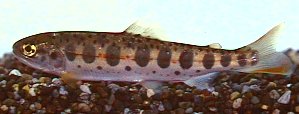 W
WOncorhynchus masou, known as the masu salmon, masu, or the cherry hybrid salmon, is a species of salmon found in the northern part of the Pacific Ocean along East Asia, ranging from the Kamchatka, Kuril Islands, Sakhalin, and Primorsky Krai south through Korea, Taiwan, and Japan. A number of subspecies are known, including the anadromous, widespread masu Oncorhynchus masou masou, the critically endangered, landlocked Taiwanese or Formosan salmon Oncorhynchus masou formosanus found in certain freshwater systems of Taiwan, the Biwa trout endemic of Lake Biwa, and the anadromous or stream-dwelling amago Oncorhynchus masou macrostomus restricted to western Japan.
 W
WPacific Packing and Navigation Company is a defunct salmon-canning company which operated in the U.S. state of Alaska. Incorporated under the laws of New Jersey and backed by eastern capitalists, it was formed during the spring of 1901, the idea of Roland B. Onnfroy. It consolidate into one corporation the properties and privileges of other Alaska companies and firms. It proposed to capitalize the new corporation as follows: 6 per cent debentures, $7,000,000; 7 per cent cumulative preferred stock, $12,500,000; common stock, $12,500,000.
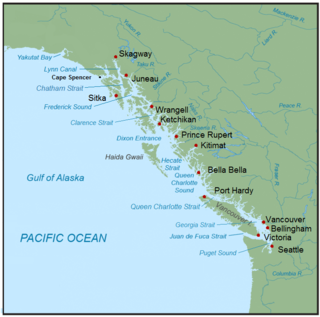 W
WThe Pacific Salmon War was a period of heightened tensions between Canada and the United States over the Pacific Salmon catch. It began in 1992 after the first Pacific Salmon Treaty, which had been ratified in 1985, expired, and lasted until a new agreement was signed in 1999. Disagreements were high in 1994, when a transit fee was set on American fishing vessels using the Inside Passage and a ferry was blockaded by fishing boats in Friday Harbor, Washington.
 W
WSalmon is a common food fish classified as an oily fish with a rich content of protein and omega-3 fatty acids. In Norway – a major producer of farmed and wild salmon – farmed and wild salmon differ only slightly in terms of food quality and safety, with farmed salmon having lower content of environmental contaminants, and wild salmon having higher content of omega-3 fatty acids.
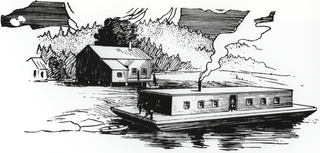 W
WA salmon cannery is a factory that commercially cans salmon. It is a fish-processing industry that became established on the Pacific coast of North America during the 19th century, and subsequently expanded to other parts of the world that had easy access to salmon.
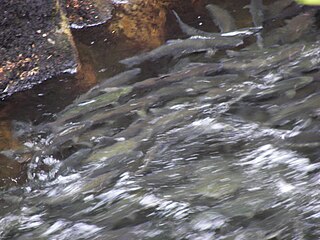 W
WThe survival of wild salmon relies heavily on them having suitable habitat for spawning and rearing of their young. This habitat is the main concern for conservationists everywhere. Salmon habitat can be degraded by many different factors including land development, timber harvest, or resource extraction. These threats bring about the traditional methods of protecting the salmon, but a new movement aims to protect the habitats before they require intervention.
 W
WThe Salmon of Knowledge is a creature figuring in the Fenian Cycle of Irish mythology, sometimes identified with Fintan mac Bóchra, who was known as "The Wise" and was once transformed into a salmon.
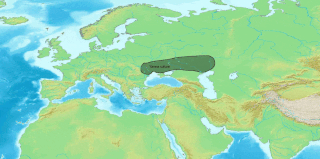 W
WIn Indo-European studies, the salmon problem or salmon argument is an outdated argument in favour of placing the Indo-European urheimat in the Baltic region, as opposed to the Eurasian Steppe, based on the cognate etymology of the respective words for salmon in Germanic and Balto-Slavic languages.
 W
WThe salmon run is the time when salmon, which have migrated from the ocean, swim to the upper reaches of rivers where they spawn on gravel beds. After spawning, all Pacific salmon and most Atlantic salmon die, and the salmon life cycle starts over again. The annual run can be a major event for grizzly bears, bald eagles and sport fishermen. Most salmon species migrate during the fall.
 W
WThe aquaculture of salmonids is the farming and harvesting of salmonids under controlled conditions for both commercial and recreational purposes. Salmonids, along with carp, and tilapia are the three most important fish species in aquaculture. The most commonly commercially farmed salmonid is the Atlantic salmon. In the U.S. Chinook salmon and rainbow trout are the most commonly farmed salmonids for recreational and subsistence fishing through the National Fish Hatchery System. In Europe, brown trout are the most commonly reared fish for recreational restocking. Commonly farmed nonsalmonid fish groups include tilapia, catfish, sea bass, and bream.
 W
WThe Chinook salmon is the largest species of Pacific salmon as well as the largest in the genus Oncorhynchus. Its common name is derived from the Chinookan peoples. Other vernacular names for the species include king salmon, Quinnat salmon, spring salmon, chrome hog, and Tyee salmon. The scientific species name is based on the Russian common name chavycha (чавыча).
 W
WThe chum salmon is a species of anadromous fish in the salmon family. It is a Pacific salmon, and may also be known as dog salmon or keta salmon, and is often marketed under the name silverbrite salmon. The name chum salmon comes from the Chinook Jargon term tzum, meaning "spotted" or "marked", while keta in the scientific name comes from the Evenki language of Eastern Siberia via Russian.
 W
WThe coho salmon is a species of anadromous fish in the salmon family and one of the five Pacific salmon species. Coho salmon are also known as silver salmon or "silvers". The scientific species name is based on the Russian common name kizhuch (кижуч).
 W
WPink salmon or humpback salmon is a species of anadromous fish in the salmon family. It is the smallest and most abundant of the Pacific salmon. The scientific species name is based on the Russian common name for this species gorbúša (горбуша), which literally means humpie.
 W
WSalmonidae is a family of ray-finned fish, the only living family currently placed in the order Salmoniformes. It includes salmon, trout, chars, freshwater whitefishes, and graylings, which collectively are known as the salmonids. The Atlantic salmon and trout of the genus Salmo gives the family and order their names.
 W
WShibetsu Salmon Science Museum opened in Shibetsu, Hokkaidō, Japan in 1991. It is dedicated to the ecology of the world's salmonids and to Hokkaidō's salmon culture. In 1992 there were 130,000 visitors, while in 2011 the number dropped to 50,000.
 W
WThe sockeye salmon, also called red salmon, kokanee salmon, or blueback salmon, is an anadromous species of salmon found in the Northern Pacific Ocean and rivers discharging into it. This species is a Pacific salmon that is primarily red in hue during spawning. They can grow up to 84 cm in length and weigh 2.3 to 7 kg (5–15 lb). Juveniles remain in freshwater until they are ready to migrate to the ocean, over distances of up to 1,600 km (1,000 mi). Their diet consists primarily of zooplankton. Sockeye salmon are semelparous, dying after they spawn. Some populations, referred to as kokanee, do not migrate to the ocean and live their entire lives in freshwater.
 W
WThe Wild Salmon Center (WSC) is an international conservation organization that works to protect wild salmon, steelhead, char, trout and the ecosystems on which these species depend. Headquartered in Portland, Oregon, United States, the WSC works with communities, businesses, governments, and other non-profits to protect and preserve healthy salmon ecosystems in the North Pacific. WSC programs range in location from Russia, Japan, Alaska, British Columbia, Washington State, Oregon, and California.